Stata:
-
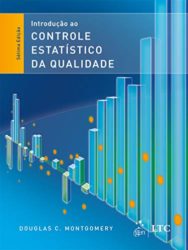 Introdução ao Controle Estatístico da Qualidade
Introdução ao Controle Estatístico da Qualidade
Mais de 40 anos de ensino, pesquisa e consultoria na aplicação de métodos estatísticos resultaram na obra Introdução ao Controle Estatístico da Qualidade que vem atender às demandas pela busca por conhecimento de processos que visam à melhoria da qualidade. Nesta 7ª edição, os leitores poderão contar com: • material inédito sobre vários assuntos, incluindo a aplicação das ferramentas da qualidade, o monitoramento de processos de Bernoulli e de processos com baixos níveis de defeitos, entre outros; • mais de 24 novas referências acrescentadas à bibliografia, o que reflete em uma exposição mais clara e mais atual de muitos tópicos; • mais de 80 exercícios acrescentados aos conjuntos de problemas de final de capítulo. Os estudantes e docentes contam também com materiais suplementares disponíveis no site da LTC Editora - GEN | Grupo Editorial Nacional, mediante cadastro, para aprofundar o apoio pedagógico. De modo claro e abrangente, o livro mostra que a qualidade deve ser a principal e mais eficaz estratégia de negócio presente nas companhias, despontando como vantagem competitiva de mercado.
2 de fevereiro de 2021 -
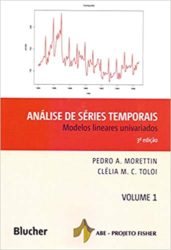 Análise de Séries Temporais: Modelos Lineares Univariados
Análise de Séries Temporais: Modelos Lineares Univariados
O texto é adequado a estudantes de várias áreas do conhecimento: estatística, matemática, engenharia, economia, finanças, oceanografia, meteorologia, etc. São descritos modelos e procedimentos para a análise de séries temporais que ocorrem nestes diversos campos, bem como são discutidos exemplos de aplicações a séries reais.O livro traz um roteiro que sugere como utilizá-lo em diversos tipos de cursos.
-
 Data Analysis Using Hierarchical Generalized Linear Models with R
Data Analysis Using Hierarchical Generalized Linear Models with R
Since their introduction, hierarchical generalized linear models (HGLMs) have proven useful in various fields by allowing random effects in regression models. Interest in the topic has grown, and various practical analytical tools have been developed. This book summarizes developments within the field and, using data examples, illustrates how to analyse various kinds of data using R. It provides a likelihood approach to advanced statistical modelling including generalized linear models with random effects, survival analysis and frailty models, multivariate HGLMs, factor and structural equation models, robust modelling of random effects, models including penalty and variable selection and hypothesis testing.
-
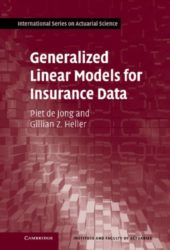 Generalized Linear Models for Insurance Data (International Series on Actuarial Science)
Generalized Linear Models for Insurance Data (International Series on Actuarial Science)
This is the only book actuaries need to understand generalized linear models (GLMs) for insurance applications. GLMs are used in the insurance industry to support critical decisions. Until now, no text has introduced GLMs in this context or addressed the problems specific to insurance data. Using insurance data sets, this practical, rigorous book treats GLMs, covers all standard exponential family distributions, extends the methodology to correlated data structures, and discusses recent developments which go beyond the GLM. The issues in the book are specific to insurance data, such as model selection in the presence of large data sets and the handling of varying exposure times. Exercises and data-based practicals help readers to consolidate their skills, with solutions and data sets given on the companion website. Although the book is package-independent, SAS code and output examples feature in an appendix and on the website. In addition, R code and output for all the examples are provided on the website.
-
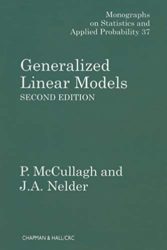 Generalized Linear Models (Chapman & Hall/CRC Monographs on Statistics and Applied Probability Book 37)
Generalized Linear Models (Chapman & Hall/CRC Monographs on Statistics and Applied Probability Book 37)
The success of the first edition of Generalized Linear Models led to the updated Second Edition, which continues to provide a definitive unified, treatment of methods for the analysis of diverse types of data. Today, it remains popular for its clarity, richness of content and direct relevance to agricultural, biological, health, engineering, and others.
-
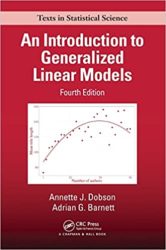 An Introduction to Generalized Linear Models
An Introduction to Generalized Linear Models
An Introduction to Generalized Linear Models, Fourth Edition provides a cohesive framework for statistical modelling, with an emphasis on numerical and graphical methods. This new edition of a bestseller has been updated with new sections on non-linear associations, strategies for model selection, and a Postface on good statistical practice.
Like its predecessor, this edition presents the theoretical background of generalized linear models (GLMs) before focusing on methods for analyzing particular kinds of data. It covers Normal, Poisson, and Binomial distributions; linear regression models; classical estimation and model fitting methods; and frequentist methods of statistical inference. After forming this foundation, the authors explore multiple linear regression, analysis of variance (ANOVA), logistic regression, log-linear models, survival analysis, multilevel modeling, Bayesian models, and Markov chain Monte Carlo (MCMC) methods.
- Introduces GLMs in a way that enables readers to understand the unifying structure that underpins them
- Discusses common concepts and principles of advanced GLMs, including nominal and ordinal regression, survival analysis, non-linear associations and longitudinal analysis
- Connects Bayesian analysis and MCMC methods to fit GLMs
- Contains numerous examples from business, medicine, engineering, and the social sciences
- Provides the example code for R, Stata, and WinBUGS to encourage implementation of the methods
- Offers the data sets and solutions to the exercises online
- Describes the components of good statistical practice to improve scientific validity and reproducibility of results.
Using popular statistical software programs, this concise and accessible text illustrates practical approaches to estimation, model fitting, and model comparisons.
-
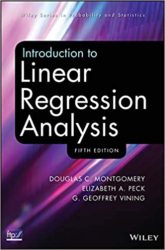 Introduction to Linear Regression Analysis
Introduction to Linear Regression Analysis
"As with previous editions, the authors have produced a leading textbook on regression."
—Journal of the American Statistical AssociationA comprehensive and up-to-date introduction to the fundamentals of regression analysis
Introduction to Linear Regression Analysis, Fifth Edition continues to present both the conventional and less common uses of linear regression in today’s cutting-edge scientific research. The authors blend both theory and application to equip readers with an understanding of the basic principles needed to apply regression model-building techniques in various fields of study, including engineering, management, and the health sciences.
Following a general introduction to regression modeling, including typical applications, a host of technical tools are outlined such as basic inference procedures, introductory aspects of model adequacy checking, and polynomial regression models and their variations. The book then discusses how transformations and weighted least squares can be used to resolve problems of model inadequacy and also how to deal with influential observations. The Fifth Edition features numerous newly added topics, including:
- A chapter on regression analysis of time series data that presents the Durbin-Watson test and other techniques for detecting autocorrelation as well as parameter estimation in time series regression models
- Regression models with random effects in addition to a discussion on subsampling and the importance of the mixed model
- Tests on individual regression coefficients and subsets of coefficients
- Examples of current uses of simple linear regression models and the use of multiple regression models for understanding patient satisfaction data.
In addition to Minitab, SAS, and S-PLUS, the authors have incorporated JMP and the freely available R software to illustrate the discussed techniques and procedures in this new edition. Numerous exercises have been added throughout, allowing readers to test their understanding of the material.
Introduction to Linear Regression Analysis, Fifth Edition is an excellent book for statistics and engineering courses on regression at the upper-undergraduate and graduate levels. The book also serves as a valuable, robust resource for professionals in the fields of engineering, life and biological sciences, and the social sciences.
-
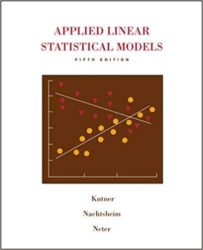 Applied Linear Statistical Models with Student CD
Applied Linear Statistical Models with Student CD
Applied Linear Statistical Models 5e is the long established leading authoritative text and reference on statistical modeling, analysis of variance, and the design of experiments. For students in most any discipline where statistical analysis or interpretation is used, ALSM serves as the standard work. The text proceeds through linear and nonlinear regression and modeling for the first half, and through ANOVA and Experimental Design in the second half. All topics are presented in a precise and clear style supported with solved examples, numbered formulae, graphic illustrations, and "Comments" to provide depth and statistical accuracy and precision. Applications used within the text and the hallmark problems, exercises, projects, and case studies are drawn from virtually all disciplines and fields providing motivation for students in virtually any college. The Fifth edition provides an increased use of computing and graphical analysis throughout, without sacrificing concepts or rigor. In general, the 5e uses larger data sets in examples and exercises, and the use of automated software without loss of understanding.
-
 Análise de Dados: Técnicas Multivariadas Exploratórias com SPSS e STATA
Análise de Dados: Técnicas Multivariadas Exploratórias com SPSS e STATA
O livro Análise de Dados: Técnicas Multivariadas Exploratórias com SPSS® e Stata® é voltado para pesquisadores que se interessam tanto por modelagem multivariada, quanto pela utilização desses importantes softwares para fins de aplicação prática e tomada de decisão. A obra é formada por três capítulos, distribuídos da seguinte forma: capítulo 1: Análise de Agrupamentos; capítulo 2: Análise Fatorial por Componentes Principais; capítulo 3: Análise de Correspondência Simples e Múltipla. Cada capítulo está estruturado dentro de uma mesma lógica de apresentação. Após a introdução dos conceitos pertinentes a cada técnica de modelagem, são utilizadas bases de dados que possibilitam a resolução de exercícios práticos em SPSS® e Stata®. Ao final de cada capítulo, são propostos exercícios com bases de dados reais, cujas respostas encontram-se ao final do livro. Esta obra é recomendada a alunos de graduação e pós-graduação stricto sensu em administração, engenharia, economia, contabilidade, atuária, estatística, psicologia, medicina e saúde e demais campos do conhecimento das ciências humanas, exatas e biomédicas. É destinada também a alunos de cursos de extensão, pós-graduação lato sensu e MBA´s, profissionais de empresas, consultores e demais pesquisadores que têm como principal objetivo o tratamento e a análise de dados para a geração de informações propícias à tomada de decisão. O livro Análise de Dados: Técnicas Multivariadas Exploratórias com SPSS® e Stata® é voltado para pesquisadores que se interessam tanto por modelagem multivariada, quanto pela utilização desses importantes softwares para fins de aplicação prática e tomada de decisão. A obra é formada por três capítulos, distribuídos da seguinte forma: capítulo 1: Análise de Agrupamentos; capítulo 2: Análise Fatorial por Componentes Principais; capítulo 3: Análise de Correspondência Simples e Múltipla. Cada capítulo está estruturado dentro de uma mesma lógica de apresentação. Após a introdução dos conceitos pertinentes a cada técnica de modelagem, são utilizadas bases de dados que possibilitam a resolução de exercícios práticos em SPSS® e Stata®. Ao final de cada capítulo, são propostos exercícios com bases de dados reais, cujas respostas encontram-se ao final do livro. Esta obra é recomendada a alunos de graduação e pós-graduação stricto sensu em administração, engenharia, economia, contabilidade, atuária, estatística, psicologia, medicina e saúde e demais campos do conhecimento das ciências humanas, exatas e biomédicas. É destinada também a alunos de cursos de extensão, pós-graduação lato sensu e MBA´s, profissionais de empresas, consultores e demais pesquisadores que têm como principal objetivo o tratamento e a análise de dados para a geração de informações propícias à tomada de decisão.